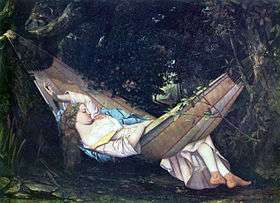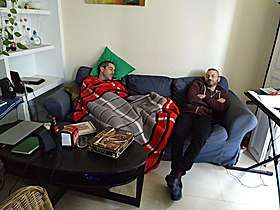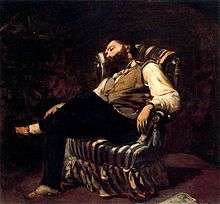Siesta
A siesta (Spanish pronunciation: [ˈsjesta]) (Spanish, meaning "nap") is a short nap taken in the early afternoon, often after the midday meal. Such a period of sleep is a common tradition in some countries, particularly those where the weather is warm.


The siesta is historically common throughout the Mediterranean and Southern Europe and Mainland China. It is the traditional daytime sleep of Spain and, through Spanish influence, the Philippines, and many Hispanic American countries. In Dalmatia (coastal Croatia), the traditional afternoon nap is known as pižolot (from Venetian pixolotto).[1] The Spanish word siesta derives originally from the Latin word hora sexta "sixth hour" (counting from dawn, hence "midday rest").
Factors explaining the geographical distribution of the modern siesta are warm temperatures and heavy intake of food at the midday meal. Combined, these two factors contribute to the feeling of post-lunch drowsiness. In many countries that practice the siesta, the summer heat can be unbearable in the early afternoon, making a midday break at home welcome.
Biological need for naps
The timing of sleep in humans depends upon a balance between homeostatic sleep propensity, the need for sleep as a function of the amount of time elapsed since the last adequate sleep episode, and circadian rhythms which determine the ideal timing of a correctly structured and restorative sleep episode. The homeostatic pressure to sleep starts growing upon awakening. The circadian signal for wakefulness starts building in the (late) afternoon. As Harvard professor of sleep medicine Charles A. Czeisler notes, "The circadian system is set up in a beautiful way to override the homeostatic drive for sleep."[2]
Thus, in many people, there is a dip when the drive for sleep has been building for hours and the drive for wakefulness has not yet started. This is, again quoting Czeisler, "a great time for a nap".[2] The drive for wakefulness intensifies through the evening, making it difficult to get to sleep 2–3 hours before one's usual bedtime when the wake maintenance zone ends.
Sleep cultures
Taking a long lunch break including a nap is common in a number of Mediterranean, tropical, and subtropical countries. The Washington Post of 13 February 2007 reports at length on studies in Greece that indicate that those who nap have less risk of heart attack.[3]
Siesta was also common in Italy, where it is called riposo in Northern Italy and pennichella or pisolino in Southern Italy. Many museums, churches and shops close during midday (from 12:00–1:30 pm to 2:30–4:00 pm) so that proprietors can go home for lunch and sometimes a nap during the day’s hottest hours.[4][5]
In the United States, the United Kingdom, and a growing number of other countries, a short sleep has been referred to as a "power nap", a term coined by Cornell University social psychologist James Maas[6] and recognized by other research scientists such as Sara Mednick[7] as well as in the popular press.[8] Siesta is also practiced in some still colder regions, such as Patagonia.[9][10]
On farms in rural Norway, farmers traditionally wake up early to care for their livestock. This is followed by an early lunch break after which a two- to three-hour nap is taken.
It used to be the custom in Russia, with Adam Olearius stating such was "the custom of the Countrey, where sleep is as necessary after Dinner as in the Night".[11] One source of hostility toward False Dmitriy I was that he did not "...indulge in the siesta."[12]:535
Einhard's Life of Charlemagne describes the emperor's summertime siestas: "In summer, after his midday meal, he would eat some fruit and take another drink; then he would remove his shoes and undress completely, just as he did at night, and rest for two or three hours."[13]
Spain
In modern Spain, the midday nap during the working week has largely been abandoned among the adult working population.[14] According to a 2009 survey, 16.2 percent of Spaniards polled claimed to take a nap "daily", whereas 22 percent did so "sometimes", 3.2 percent "weekends only" and the remainder, 58.6 percent, "never". The share of those who claimed to have a nap daily had diminished by 7 percent compared to a previous poll in 1998. Nearly three-fourths of those who take siesta claimed to do so on the sofa rather than on the bed. The habit is more likely among the elderly or during summer holidays in order to avoid the high temperatures of the day and extend social life till the cooler late evenings and nights.[15]
English language media often conflate the siesta with the two to three hour lunch break which is characteristic of Spanish working hours,[16] even though the working population is less likely to have time for a siesta and the two events are not necessarily connected. In fact, the average Spaniard works longer hours than almost all their European counterparts (typically 11-hour days, from 9am to 8pm).[17]
As for the origins of the practice in Spain, the scorching summer heat predominant mostly in the South is thought to have motivated those doing agrarian work to take a break to avoid the hottest part of the day. In cities, the dismal economic situation in Spain in the post-Spanish Civil War years coincided with the advent of both a modern economy and urbanisation. At that time, a long midday break—with or without siesta—was necessary for those commuting between the part-time jobs which were common in the sputtering economy.[18]
Cardiovascular benefits

The siesta habit has been associated with a 37 percent reduction in coronary mortality, possibly due to reduced cardiovascular stress mediated by daytime sleep.[19]
Epidemiological studies on the relations between cardiovascular health and siesta have led to conflicting conclusions, possibly because of poor control of confounding variables, such as physical activity. It is possible that people who take a siesta have different physical activity habits, for example, waking earlier and scheduling more activity during the morning. Such differences in physical activity may lead to different 24-hour profiles in cardiovascular function. Even if such effects of physical activity can be discounted in explaining the relationship between siesta and cardiovascular health, it is still not known whether the daytime nap itself, a supine posture, or the expectancy of a nap is the most important factor.[20]
Further reading
- Naska, A.; Oikonomou, E.; Trichopoulou, A.; Psaltopoulou, T.; Trichopoulos, D. (2007). "Siesta in healthy adults and coronary mortality in the general population". Archives of Internal Medicine: 167, 296–301.CS1 maint: ref=harv (link)
- Zaregarizi, MohammadReza; Edwards, Ben; George, Keith; Harrison, Yvonne; Jones, Helen; Atkinson, Greg (2007). "Acute changes in cardiovascular function during the onset period of daytime sleep: Comparison to lying awake and standing". American J Appl Physiol. 103: 1332–1338.CS1 maint: ref=harv (link)
- Zaregarizi, MohammadReza (March 2012). Effects of Exercise & Daytime Sleep on Human Haemodynamics: With Focus on Changes in Cardiovascular Function during Daytime Sleep Onset. ISBN 978-3-8484-1726-1.CS1 maint: ref=harv (link)
References
- Anić, Vladimir & Goldstein, Ivo (1999). Rječnik Stranih Riječi, p998. Zagreb: Novi Liber.
- Lambert, Craig, PhD (July–August 2005). "Deep into Sleep. While researchers probe sleep's functions, sleep itself is becoming a lost art". Harvard Magazine. Retrieved 25 February 2008.
- Stein, Rob. "Midday Naps Found to Help Fend Off Heart Disease", Washington Post, 13 February 2007, p. A14.
- Finzi, Jerry (23 May 2016). ""Chiuso" means Closed in Italy: The Midday Riposa (Siesta), The Italian Siesta". GRAND VOYAGE ITALY. Retrieved 28 May 2019.
- "Open hours in Italy". www.reidsitaly.com. Retrieved 28 May 2019.
- Maas, James B. (1998) Miracle Sleep Cure: London: Thorsons
- "The National Institute of Mental Health Power Nap Study". 1 July 2002. Archived from the original on 2 August 2002. Retrieved 1 July 2002.
- "Researchers: Power Nap Better than Caffeine to Fight Afternoon Fatigue". Fox News. 4 September 2007.
- "9 Things You Must Understand Before Traveling in Argentina". blogpatagonia.australis.com. Retrieved 28 May 2019.
No, your standard Argentinian is instead kicking back with a well-earned snooze or siesta. [...] The siesta probably has its origins in the fact that Argentine society rarely sees morning hours – unless they’ve yet to go to bed that is.
- "Important Argentina Traditions and Where to Experience Them". blogpatagonia.australis.com. Retrieved 28 May 2019.
A tradition brought by the conquistadors from Spain, but continued enthusiastically by modern Argentineans, siestas are an important part of the day for people in Argentina. [...] Initially a way of avoiding the fierce heat of midday, in parts of southern Argentina where the heat is less intense, the siesta is instead a time for family members to eat together. Normally siestas are held between 1pm and 4pm so be aware that, when traveling in Argentina, you’re unlikely to find much activity in small towns during this part of the day.
- The Voyages and Travells of the Ambassadors Sent by Frederick Duke of Holstein, to the Great Duke of Muscovy, and the King of Persia: Begun in the Year M.DC.XXXIII, and Finish'd in M.DC.XXXIX : Containing a Compleat History of Muscovy, Tartary, Persia, and Other Adjacent Countries : with Several Publick Transactions Reaching Near the Present Times : in VII Books, page 5 of Book 1
- Howorth, Henry H (1880). History of the Mongols from the 9th to the 19th Century. Part 2. The So-Called Tartars of Russia and Central Asia. London: Longmans, Green, & Co. Retrieved 4 July 2016.
- Einhard, Life of Charlemagne, §24.
- "Costumbres y curiosidades de España - Escuelapedia - Recursos Educativos" (in Spanish). Retrieved 5 October 2015.
- "Spanish siesta: The Spanish siesta myth or reality?". El País. Retrieved 19 June 2016.
- La prensa internacional ironiza: Rajoy quiere quitar la siesta|España|El País
- Paul Kelley (22 February 2017). "Spaniards' lack of sleep isn't a cultural thing - they're in the wrong time zone". The Guardian.
- "Out of sync with the sun..." The Economist. Retrieved 18 August 2016.
- Naska et al. 2007.
- Zaregarizi 2012.
External links
| Wikimedia Commons has media related to Siesta. |
- Why we could all do with a Siesta – An article about research results from the University of Manchester.
- Is there a decline in Siesta - An article about the decline in siesta.
- Medical disadvantages correlated with Siesta - An article from the Oxford Journal.